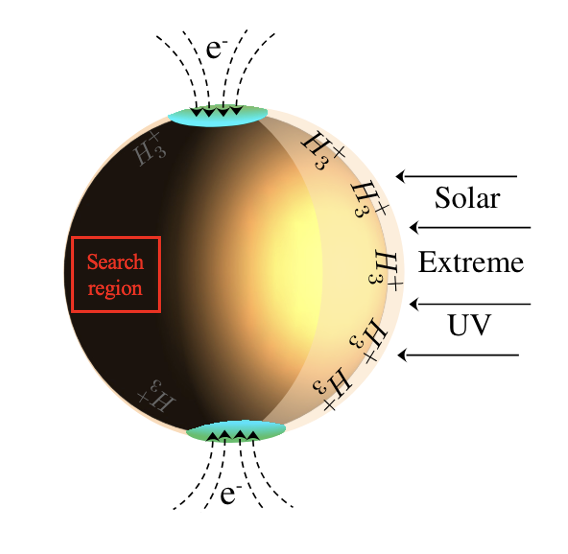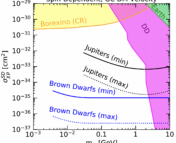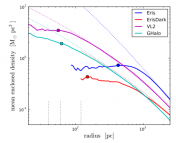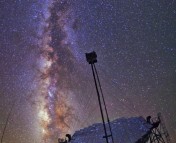Title: Search for dark matter ionization on the night side of Jupiter with Cassini
Authors: Carlos Blanco and Rebecca K. Leane
First Author’s Institution: Princeton University, Department of Physics, Princeton, NJ; Stockholm University and The Oskar Klein Centre for Cosmoparticle Physics, Alba Nova, Stockholm, Sweden
Status: Accepted to PRL [open access]
Although dark matter makes up over 80% of the total matter content of the Universe, we have yet to detect it. Not only is dark matter effectively invisible (it doesn’t reflect, absorb, or emit light), we also don’t really know much about it — like how massive it is or how likely it is to interact with other particles — which makes searching for it a particularly daunting endeavor. Over the years, researchers have implemented a variety of search strategies, ranging from building enormous liquid xenon detectors that will scintillate if dark matter particles hit them, to smashing particles together in colliders to try to create dark matter. In today’s paper, the authors present a new approach using Jupiter as a dark matter detector.

If dark matter particles captured by Jupiter were to collide and destroy (or “annihilate”) each other, it would produce hydrogen ions (H3+) that emit infrared radiation. Therefore, an observation of this infrared radiation would indicate a detection of dark matter. However, H3+ is also produced by other processes on Jupiter, particularly from auroras at high latitudes near Jupiter’s magnetic poles and from solar extreme ultraviolet radiation incident on the side of Jupiter facing the Sun (the day side). In order to isolate the H3+ originating from dark matter annihilation, the authors focus their search on a low-latitude region on the side of Jupiter facing away from the Sun (the night side) (shown in Figure 1).
H3+ data collected by the Visual and Infrared Mapping Spectrometer (VIMS) aboard the Cassini spacecraft as it flew by Jupiter indicated that no H3+ was detected in this region. However, it’s possible that there was actually a signal present, but it was too small for the instrument to detect. This allows the authors to place an upper bound on the local H3+ abundance. Using this limit, they calculate the amount of power that would need to be present in order to produce an equivalent signal and compared this value to predictions of the power generated by annihilating dark matter. Because these predictions depend on dark matter’s mass and its scattering cross-section with nucleons, the authors were able to place constraints on these parameters in a previously unexplored part of the parameter space (shown in Figure 2).

The authors also investigated the possibility of applying this dark matter search method to exoplanets in the inner Galaxy, where the density of dark matter is expected to be high. In particular, researchers are interested in super-Jupiters, which are exoplanets similar to Jupiter, but more massive, which means they can more readily capture dark matter. Because of their distant locations, it’s not possible to spatially resolve low latitude signals for these exoplanets, meaning that there will be a background of H3+ signal from auroras at their poles. However, the combination of their large mass and position in a high-density dark matter environment enable these exoplanets to overcome this background and place even tighter dark matter constraints than Cassini (orange dashed lines in Figure 2).
Although dark matter hasn’t been detected (yet!), the authors of today’s paper have brought a new approach to the search effort, with promising results.
Astrobite edited by Catherine Slaughter
Featured image credit: NASA, ESA, CSA, STScI, Ricardo Hueso (UPV), Imke de Pater (UC Berkeley), Thierry Fouchet (Observatory of Paris), Leigh Fletcher (University of Leicester), Michael H. Wong (UC Berkeley), Joseph DePasquale (STScI)




